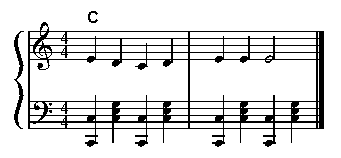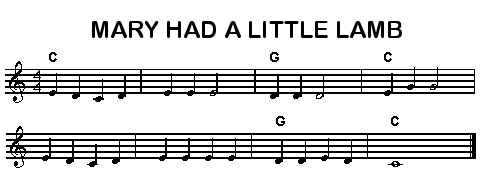Putting It Together: Mary Had A Little Lamb
Now we will play our first song. Here is the beginning of Mary Had a Little Lamb (Fig. 5) Remember: On the first beat, you play the octave. On beat two, you play the chord. Then you repeat the cycle for the rest of the beats. You may have noticed that Mary Had A Little Lamb is actually written in 4/4. To fill up the entire measure, we simply use the 2/4 pattern twice.
 |
| Fig. 5 |
What you will actually play is shown in Fig. 6. As you can see, even when the right hand is playing a half note (measure 2), the O/C cycle still continues. It may help you to think of your left hand as your metronome; it churns out a steady beat while your right hand plays the melody.
 |
| Fig. 6 |
| Example: First two measures |
The G Major O/C
The two measures shown in Fig. 5 use an O/C cycle utilizing the C Major chord, which we have already learned. Now we will learn the O/C cycle using another chord: the G Major chord. Fig. 7 and Fig. 8 show us the G Major octave and chord, respectively.
 |
 |
| Fig. 7 | Fig. 8 |
As before, we must alternate between these two positions to complete the O/C pattern. You may have noticed that the C Major O/C and the G Major O/C feel the same to your left hand, which will make learning them easier. Practice those jumps!
Mary Had A Little Lamb
I believe it’s time for our first song to be completed. Let’s try Mary Had A Little Lamb in its entirety (Fig. 9). You will use both the C Major O/C and the G Major O/C in the 2/4 pattern. Look above each measure, and see what chord name is listed there. Play that O/C, and if there is no chord given, then play the chord from the previous measure. Have fun!
 |
| Fig. 9 |
| Example: Mary Had A Little Lamb, complete |
